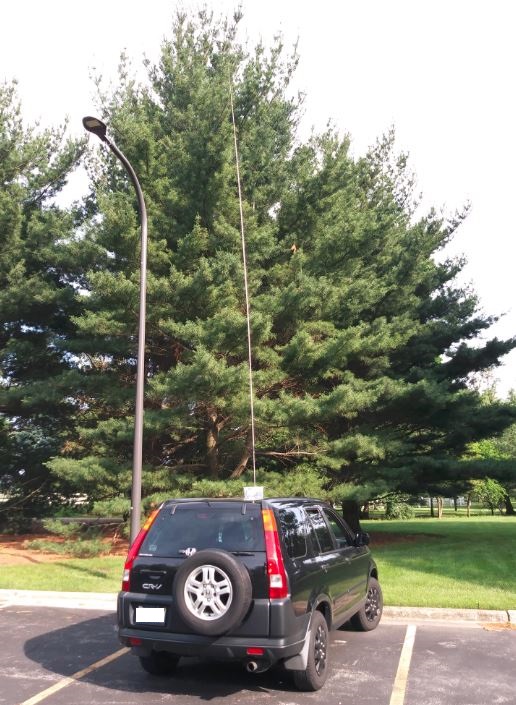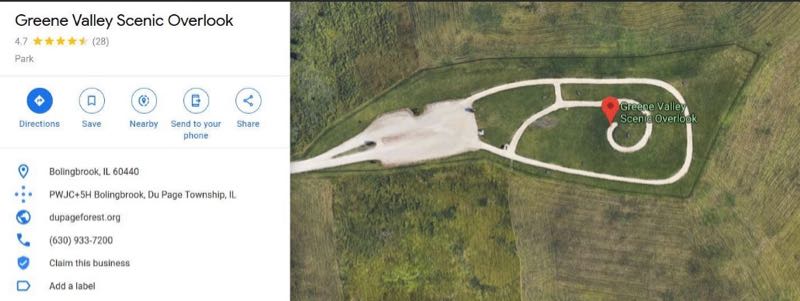Many thanks to SWLing Post contributor, TomL, who shares the following guest post:
Summer Daytime DXing 2019
by TomL
I took note of the mediocre band conditions this summer amongst amateur radio operators as they were making off the cuff comments about still being in a solar minimum. Some had gone out and bought upgraded transmitters to solve the problem (MOAR WATTS!). And more power thrown at a weak ionosphere does seem to help get a signal farther. I had not been out since the spring and decided to find out for myself. But instead of more watts, I wanted more height.
Greene Valley Scenic Overlook is open to the public from May through October on weekends only (and only from 11am-6pm). It was the largest land fill (aka, garbage dump) in Illinois, now covered over and producing captured methane gas. On August 3 & 4, I ventured over there to see if its 190 feet above the surroundings might help my radio reception.
After trying my luck with a 12 foot vertical antenna on a tripod (and numerous children running around it chasing butterflies or looking at the view of Chicago), I went out the next day and parked away from anyone and put up my 19 foot vertical on the roof of the car. This setup is still amazing to me and works much better than the tripod mounted antenna, probably because it has a proper ground plane as well as being 7 foot taller.
So, yes, the conditions were so-so, not too bad and not too good. Lots of weak signals and some empty frequencies that I had expected to hear some South American stations around the 5 – 10 kw range. Weak stations from Asia were more scratchy sounding than usual even with the extra 190 feet of height. Here are 5 broadcast recordings as a sample (times in UTC):
9920 kHz at 21.14 – Radio Thailand in Thai, just catching the end of the broadcast:
9685 kHz at 21.20 – Radio Free Asia in Chinese from Kuwait:
9650 kHz at 21.23 – Radio Guinea in French:
9445 kHz at 21.30 – All India Radio in English (fighting off computer generated noise on my SDR and cheap Dell laptop) and just getting a station identification:
11780 kHz at 21.44 – Radio Nacional de Amazonia booming in with the usual annoying host yelling enthusiastically over every tune he played:
Running out of things to listen to, I wandered over to the 20 meter amateur radio band and found a different situation. Propagation was decent between the Western hemisphere and Europe. Lots of “pile ups” going on with people trying to make contact with their trans-Atlantic counterparts. Some said they were running 500 watts or more, so more power does seem to help! Here are 5 recordings to show how active it was:
14171 kHz at 21.55 – Inaki (F5RAG) from southwestern France conversing with Carlos (YV3CRT) in Venezuela (surprised anyone is left in Venezuela with operating radio equipment and not sold off for food with the ongoing difficulties there). Then Inaki makes contact with Alejandro (CE2ATS) from Chile with a good signal. All in Spanish:
14199.38 kHz at 22.04 – Ervin (VE3GAL) tries his QRP portable setup from Ontario to contact Ron (F4VSM) in Southwestern France who has a 500 watt setup and large Yagi antenna. Sometimes things do not go so well but that is the challenge of using low power, maybe around 10 watts (meaning that just because you can hear them, you cannot always transmit to them with the same effectiveness and vice-versa, for various reasons):
14228 kHz at 22.12 – “BAN” (IZ1PNT) from Italy makes contact with Norman (N3PVQ) in FL after asking everyone to be quiet. Good control over the frequency:
14238 kHz at 22.17 – Slavko (S57DX) booming in, making a contact (Rob, KK4HEQ) in Florida:
14245 kHz at 22.24 – Gabrielle from the Czech Republic, participating at a Youth event using station OL88YL contacting Ira (VP2EIH) in the British Virgin Islands and then another dude from Florida, Roy (AD4AN). She handled it very well:
This outing was quite educational and I find it curious that people running 1000 watts or less are able to be heard well between continents but the large broadcasters were difficult to hear. Antennas pointed in the right direction, at the right time of day and frequency, can certainly do amazing things, plucking those weak signals out of the air so easily. And I do think the extra height had something to do with hearing this magic, too!
Happy Listening,
TomL
NOTES:
- An easy way to lookup amateur radio operator “call signs” is to go to web site QRZCQ.com which does not need a login. Some records may be out of date, but most of it is accurate.
- Setup used was a cheap Dell laptop, Windows 10, SDR Console 3.03, connected to the AirSpy HF+, a Palstar amplified preselector, and an old Kiwa BCB filter, then going up to the car roof magnetic balun (a Palomar MLB2) which is then connected to the 4 magnet base and the MFJ 19 foot stainless steel antenna. You can read about it here:
https://swling.com/blog/2018/07/guest-post-backpack-shack-3-0-part-3/
Brilliant report, Tom! It’s true: the bands are fickle, but like you I always find interesting things to hear on HF. I think your setup using your vehicle as the ground plane for the antenna is a fantastic idea. Plus, set up is easy, self-supporting, and you’ll never have to worry about a park ranger, for example, complaining because you have a wire suspended from a tree. And when there are no trees? You’re still golden.
Thanks for sharing your experience and DX! Amazing that even with mediocre conditions, you still snagged some distant signals.
Do you enjoy the SWLing Post?
Please consider supporting us via Patreon or our Coffee Fund!
Your support makes articles like this one possible. Thank you!



